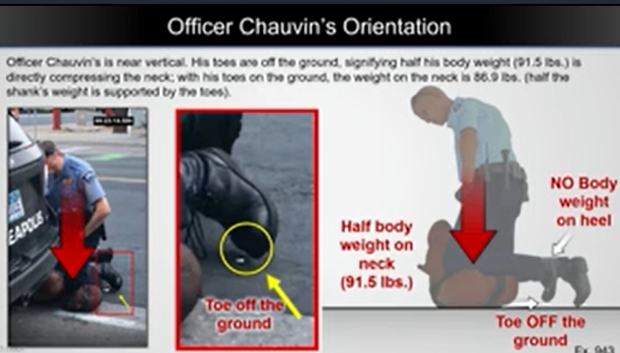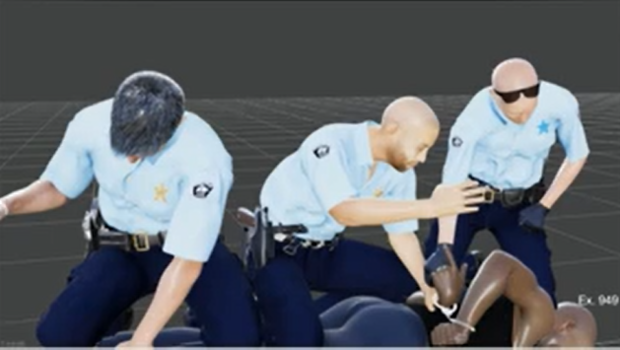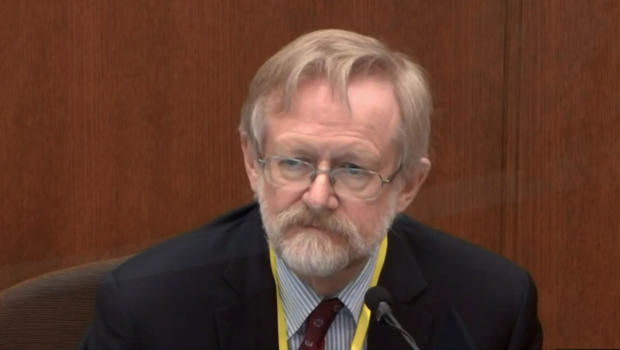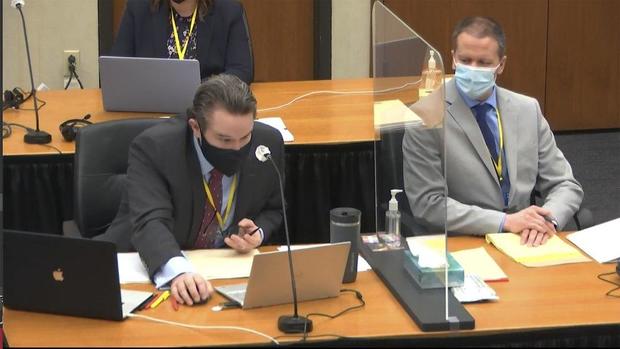Derek Chauvin Trial 4/8/21: Floyd died of lack of oxygen, caught in "vise" between officers and street, expert says
get the free appFollow the latest trial updates here. Earlier coverage is below.
George Floyd died from a low level of oxygen that damaged his brain and caused his heart to stop, a medical expert testified Thursday in the trial of Derek Chauvin, the fired Minneapolis officer charged in Floyd's death. Dr. Martin Tobin, an expert who specializes in pulmonology and critical care, was the first witness called to the stand on the ninth day of the trial.
Tobin, a Chicago-based physician who is a renowned expert in medical issues involving the lungs and respiratory system, testified that Floyd's "shallow breaths weren't able to carry air through his lungs, down to the essential areas of the lungs that get oxygen into the blood and get rid of carbon dioxide."
Tobin said the weight from officers forcing Floyd's left wrist high into his chest and an officer's knee on his left side, in addition to the pressure from the street on the other side of Floyd's body, acted like a "vise" and constricted his left lung from expanding. Floyd was trying to use his right hand to push up the right side of his body in order to take in air on the right side, "literally trying to breathe with his fingers and knuckles," Tobin said.
At the same time, Chauvin's knee on Floyd's neck was at various points putting pressure on Floyd's hypopharynx, a small area at the bottom part of the throat, further compromising his breathing, Tobin said. Chauvin kept his knee on Floyd's neck for three minutes and 27 seconds after Floyd took his last breath, Tobin testified, well after there was "not an ounce of oxygen left in his body."
Tobin discounted the defense's suggestion that Floyd's underlying heart conditions and fentanyl use contributed to his death.
"A healthy person subjected to what Mr. Floyd was subjected to would have died as a result of what he was subjected to," Tobin said.
Later, emergency medical physician and forensic medicine specialist Dr. Bill Smock took the stand and gave a similar opinion, saying Floyd died not of a drug overdose, but because he had "no air left in his body."
The testimony on Floyd's cause of death follows evidence presented Wednesday about Floyd's drug use. A forensic scientist testified that she found Floyd's blood and pills with Floyd's DNA on them in the squad car where he struggled with officers.
The testimony is significant because Floyd's cause of death has been a key point of dispute at the trial. The defense has suggested Floyd, who suffered from heart disease, died of a heart arrhythmia brought on by drugs he ingested. The prosecution argues Floyd died of oxygen deprivation from being pinned down under Chauvin's knee.
Chauvin, who was seen in disturbing videos kneeling on Floyd's neck for more than nine minutes, is charged with second-degree murder, third-degree murder and second-degree manslaughter.
Chauvin has pleaded not guilty. The other three officers involved are charged with aiding and abetting, and are expected to be tried jointly in August.
Defense hones in on Floyd's heart disease
On cross-examination, defense attorney Eric Nelson honed in on Floyd's pre-existing cardiovascular disease, pointing out that Floyd had a 90% blockage of the right coronary artery. Nelson asked the forensic medicine expert, Dr. Bill Smock, whether a struggle with police would put stress on the heart, and whether people have had cardiac arrhythmias while struggling with police before. Smock said they had. Asked whether someone who had ingested both methamphetamine and fentanyl would be at greater risk for suffering heart complications, Smock said it would depend on the circumstances.
Smock also agreed with Nelson that someone who had once had a tolerance to opioids could lose the tolerance if they stopped using the drug for a period of weeks or months.
On re-direct questioning from prosecutor Jerry Blackwell, Smock said there is "absolutely no evidence" that Floyd died of a heart attack, a fentanyl overdose or a methamphetamine overdose. Court then recessed for the day.
Doctor: Floyd's pleas for air showed he did not die of overdose
Dr. Bill Smock, a Louisville-based emergency medical physician who specializes in forensic medicine, said Floyd did not die from a fentanyl overdose, as the defense has suggested.
Smock said Floyd's pleas of "I can't breathe" are an example of "air hunger," which he called "the human desire to live, to breathe." He described a drowning person struggling to get to the surface of the water. Someone suffering from a fentanyl overdose would not experience "air hunger" because their body would be in "sleep mode," and their respiration would gradually slow until they enter a coma, Smock said.
That Floyd was breathing and talking before he died shows he was not suffering a fentanyl overdose, Smock said. Smock said Floyd was a chronic user of opioids who had developed a tolerance to the drug.
"He's breathing, he's talking, he's not snoring, he is saying, 'Please, please, get off me, I want to breathe, I can't breathe,'" Smock said. "That is not a fentanyl overdose, that is someone begging to breathe."
Floyd's niece Tiffany Hall, sitting in the lone seat reserved for George Floyd's family members, cried as prosecutors played body camera video of Floyd being pinned to the ground.
Forensic medicine specialist: Floyd died "because he had no oxygen left in his body"
Dr. Bill Smock, a Louisville-based emergency medical physician who specializes in forensic medicine, has taken the stand. When asked by prosecutor Jerry Blackwell about his opinion of the cause of George Floyd's death, Smock said: "Mr. Floyd died from positional asphyxia, which is a fancy way of saying he died because he had no oxygen left in his body."
Floyd gradually succumbed to the pressure on his chest and back, Smock said.
Forensic toxicologist takes the stand
Daniel Isenschmid, a Pennsylvania-based forensic toxicologist, has taken the stand. Isenschmid said he tested George Floyd's blood and found it contained both methamphetamine and fentanyl. Isenschmid also said he found the presence of norfentanyl, a metabolite of fentanyl which indicates the body has begun to break down fentanyl.
Isenschmid said patients who die of fentanyl overdose typically do not have norfentanyl in their blood. He agreed Floyd's level of methamphetamine was "exceptionally low" compared to a data sample of under-influence drivers with methamphetamine in their system.
Pulmonologist disputes his work is based on "assumptions"
Under cross-examination by defense attorney Eric Nelson, Dr. Tobin said he has not previously testified in criminal trials and so volunteered his services to the Minnesota Attorney General's office. Tobin also confirmed he is not a pathologist. He said he has reviewed Floyd's autopsy results and is aware there was no bruising to Floyd's body and no damage recorded to Floyd's hypopharynx, a small area at the bottom part of the throat. Tobin had testified earlier for prosecutors that Chauvin's knee was at certain points placing pressure on the hypopharynx, which would affect Floyd's ability to breathe.
Tobin pushed back when Nelson asked whether he used assumptions in his application of science, saying his work was based on "very few assumptions," but rather "direct measurements" and "extensive research." Tobin later agreed that he did not know Chauvin's exact weight or the weight of his equipment when determining the amount of pressure on Floyd's neck was more than 90 pounds. He also agreed that his measurements assumed Chauvin was equally distributing his weight between his right and left leg. When Nelson asked whether weight is "pretty frequently re-distributed," Tobin replied, "That is correct."
Tobin agreed that prior to the moment of Floyd's death, he would have appeared to have been breathing. Tobin confirmed he was able to count Floyd's breaths on the video to determine his respiratory rate.
On re-direct questioning by prosecutor Jerry Blackwell, Tobin said he wouldn't expect damage to the hypopharynx or bruising to be discovered on Floyd's body. "The effects are not going to remain at the time of autopsy," he said. Likewise, he said the low level of oxygen that caused Floyd's death "won't leave any fingerprints afterward."
Defense cross-examines pulmonologist
Court has returned from a lunch break. Defense attorney Eric Nelson is cross-examining pulmonologist Dr. Martin Tobin.
Pulmonologist: Fentanyl did not play role in Floyd's death
Tobin said he did not believe fentanyl played a role in Floyd's death, as the defense has suggested. Tobin said he was able to determine Floyd's respiratory rate by counting Floyd's breaths just before he lapsed into unconsciousness, and that the rate was normal. Someone whose breathing has been affected by fentanyl would have a respiratory rate below normal, he said.
Tobin also addressed the high level of carbon dioxide in Floyd's body, which the defense has suggested could be linked to fentanyl use. But Tobin said the elevated level of carbon dioxide would be expected because nine minutes and 50 seconds lapsed between the time Floyd is seen on the video drawing his last breath and the time paramedics inserted breathing device into his airway. Carbon dioxide would naturally build up in the body at an expected rate in the body of someone who was not breathing for that amount of time, he said.
Tobin said Chauvin left his knee on Floyd's neck for three minutes and 27 seconds after Floyd took his last breath, and two minutes and 44 seconds after officers could not find a pulse. Tobin pointed out on the video for jurors when Floyd died, saying, "That's the moment the life goes out of his body."
Pulmonologist: Chauvin kept knee on Floyd after there was "not an ounce of oxygen left in his body"
Dr. Tobin testified Chauvin kept his knee on Floyd's neck after there was "not an ounce of oxygen left in his body." Tobin pointed to an extension of Floyd's leg that he said was a seizure indicating "fatal injury to the brain from a lack of oxygen."
Tobin testified that a person with no underlying medical conditions would have died under the same circumstances as Floyd.
"A healthy person subjected to what Mr. Floyd was subjected to would have died as a result of what he was subjected to," Tobin said.
Prosecutor Jerry Blackwell asked Tobin whether it's a true statement that "if you can talk, you can breathe." Chauvin made a similar statement to Floyd as he was being restrained. Tobin said the statement is true on the surface, but is "misleading" and "highly, highly dangerous." He said Floyd's ability to say "I can't breathe" showed that he had oxygen flow to his brain at that moment, but moments later, he did not.
"It gives you an enormous false sense of security — certainly at the moment you are speaking, you are breathing, but it doesn't tell you that you're going to be breathing five seconds later," Tobin said.
Pulmonologist: Floyd had to "fight" to breathe
Dr. Tobin testified someone who is in the prone position will see their lung volume drop by 24% and will have to expend more effort to breathe. Typically, he said, this would not be dangerous. But for George Floyd, with the lowered lung volume from the prone position combined with the pressure from the knees on his neck and back, and being unable to move his left lung, "it's a whole different kettle of fish."
Even without the pressure on his neck, the pressure on his back and side would have hugely affected Floyd's ability to breathe, Tobin said.
"The work Mr. Floyd has to perform becomes huge, because he has to, with each breath, has to fight against the street, fight against the small volumes he has, try to lift up the knee with each breath and lift the effect of the other officer pushing his arm into his side," Tobin said. "He has to make all these efforts to try to breathe against that."
Pulmonologist: Chauvin's bodyweight compressed Floyd's neck
At certain points, the pressure from Chauvin's knee on Floyd's neck caused a narrowing of Floyd's airway, Dr. Tobin testified.
"As you are narrowing and narrowing, the effort to breathe is going to become higher and higher, and at some point unsustainable — you're just not going to be able to do it," Tobin said.
At one point, Tobin said Chauvin was positioned above Floyd, nearly vertical with his toe no longer on the ground, directing his bodyweight to Floyd's neck and amounting to more than 90 pounds of pressure, Tobin said.
Expert: Floyd couldn't expand left lung
The weight from officers forcing Floyd's left wrist high into his chest and the knee on his left side, in addition to the pressure from the street on the other side of Floyd's body, also interfered with Floyd's ability to expand his left lung, Tobin said.
"It's almost like the effect a surgeon had gone in and removed the lung ... there's very little opportunity for him to get any air on the left side, so he's totally dependent on the right side," Tobin said.
Floyd was trying to use his right hand to push up the right side of his body in order to take in air on the right side, "literally trying to breathe with his fingers and knuckles," Tobin said.
At the same time, Chauvin's knee on Floyd's neck was at various points putting pressure on Floyd's hypopharynx, a small area at the bottom part of the throat. Direct pressure on the area would cause a drop in oxygen levels resulting in a seizure or heart attack, Tobin said.
Doctor: Pressure on Floyd was like a "vise"
Tobin displayed an animation showing the position of Floyd and the three officers restraining him which he said he used in his analysis of how Floyd died. Tobin said Chauvin's knee was "virtually on the neck for the vast majority of the time" — more than 90% of the time, he said.
Tobin said the pressure from Chauvin and Kueng pushing Floyd's handcuffs into one side of his body and the pressure from the street on the other side both interfered with central features of his breathing.
"It's like the left side is in a vise, totally being pushed in, squeezed from each side," Tobin said.
Pulmonologist: Floyd died of low oxygen level
Dr. Martin Tobin, a Chicago-based physician who is a renowned expert on pulmonology (medical issues involving the lungs and respiratory system), testified that Floyd died of a low level of oxygen.
Tobin said Floyd's "shallow breaths weren't able to carry air through his lungs, down to the essential areas of the lungs that get oxygen into the blood and get rid of carbon dioxide."
Tobin testified the shallow breathing resulted from Floyd being prone on the street and handcuffed, with a knee on his neck and back and an arm at his side.
Court resumes with pulmonologist's testimony
Court has resumed for the day. Dr. Martin Tobin, a Chicago-based physician who specializes in pulmonology and critical care, has taken the stand.
Dispute over Floyd's "drugs" remark
The defense attorney for former Minneapolis police officer Derek Chauvin may have planted a seed of doubt in jurors' minds as prosecutors present their case.
At one point during questioning Wednesday, state investigator James Reyerson agreed with the defense suggestion that Floyd appeared to say on police bodycam video, "I ate too many drugs." But the audio was difficult to understand, and after hearing what was said right before it, Reyerson amended his statement to say he believes Floyd said, "I ain't do no drugs."
CBS News correspondent Jamie Yuccas has a recap of the day's developments in the video below.
Floyd's cause of death a key point of dispute
A key point of dispute in the trial has been how Floyd died. During opening statements last week, prosecutors played the video of Floyd being pinned down, saying Chauvin used lethal force against a "defenseless" and handcuffed Floyd for nine minutes and 29 seconds. Prosecutor Jerry Blackwell said Floyd died of oxygen deprivation beneath the pressure of Chauvin's knee. But the defense argued Floyd, who suffered from heart disease, died of a heart arrhythmia complicated by the fentanyl and methamphetamine he ingested before his arrest.
Wednesday, a forensic scientist testified she discovered Floyd's DNA on pills she found in the backseat of the squad where Floyd struggled with officers. She collected and tested the pills months after the fatal arrest at the request of the defense. A forensic chemist testified they contained fentanyl and methamphetamine.
Monday, Dr. Bradford Langenfeld, the emergency doctor who tried to resuscitate Floyd and ultimately pronounced him dead, testified that paramedics did not tell him that Floyd suffered a drug overdose or a heart attack. When asked by Blackwell whether he believed oxygen deficiency was the cause of Floyd's death, he responded it was "one of the more likely possibilities."
Langenfeld agreed a more common term for the possible cause of death would be asphyxia.
Under questioning from defense attorney Eric Nelson, Langenfeld agreed that drug use, including from methamphetamine and fentanyl, can cause a lack of oxygen to the brain. Langenfeld agreed that Floyd had "exceptionally high" levels of carbon dioxide in his system, which he agreed can result from fentanyl use. Langenfeld testified that heightened levels of carbon dioxide can affect the respiratory system and cause a feeling of shortness of breath.
Later, on re-direct questioning from Blackwell, Langenfeld said he considered the elevated carbon dioxide level to be "weak evidence" in relation to Floyd's cause of death, because it indicates someone's heart has stopped but no indication as to why.
The charges
In order to convict Chauvin of second-degree murder, prosecutors will need to prove beyond a reasonable doubt that Chauvin caused Floyd's death while committing or attempting to commit a related felony, in this case third-degree assault. To convict the former officer of third-degree murder, prosecutors must convince the jury that Chauvin caused Floyd's death during an act that was "eminently dangerous to others and evincing a depraved mind, without regard for human life."
The third-degree charge was initially dropped by Judge Cahill, but was re-instated earlier this month after an appeals court handed a win to prosecutors.
To convict Chauvin of second-degree manslaughter, prosecutors will need to prove beyond a reasonable doubt that Chauvin caused Floyd's death by "culpable negligence," meaning he created unreasonable risk and consciously took a chance of causing death or serious harm.
Prosecutors do not need to prove that Chauvin intended to cause Floyd's death. Since police officers are authorized to use force, prosecutors must prove that the force Chauvin used against Floyd was unlawful.
In Minnesota, second-degree murder carries a maximum sentence of 40 years in prison. Third-degree murder is punishable by up to 25 years. Second-degree manslaughter carries a maximum prison term of 10 years.




